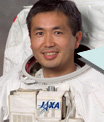JAXA Astronaut Activity Report, December 2007
Last Updated: February 25, 2008
This is JAXA's Japanese astronaut primary activity report for December 2007.
Dextre (Special Purpose Dexterous Manipulator: SPDM) operations training
To become qualified for operating the Special Purpose Dexterous Manipulator (SPDM), also known as “Dextre,” developed by the Canadian Space Agency (CSA), astronauts Wakata and Noguchi underwent training for approximately one week at CSA.
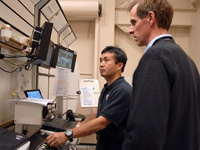
Astronaut Wakata using a simulator for simulating Dextre operations.(Source: Canadian Space Agency 2008)
Dextre is one of the three components that comprise the International Space Station’s remote manipulator system known as the Mobile Servicing System (MSS). The other two components of the MSS, “Canadarm2” and “Mobile Base System (MBS),” were delivered to the ISS on previous ISS assembly missions and have already been operated for ISS assembly or support tasks. The MSS is designed to move along the ISS truss and to support the transfer of equipment and conduct of Extravehicular Activities. Dextre will be delivered to the ISS during the STS-123 (1J/A Flight) Mission, along with the Kibo Experiment Logistics Module - Pressurized Section (ELM-PS).
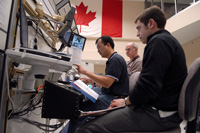
Astronaut Noguchi simulating the operation of Dextre on a simulator (Source: Canadian Space Agency 2008)
During the training, the astronauts attended lectures and participated in hands-on exercises using simulators and full-scale mockups. On the final day of training, a skill test was conducted. After Dextre is launched and installed on the ISS, at least one of the ISS Expedition crew members will be required to have qualifications for operating Dextre.
Training for transfer operations between the ISS and the Space Shuttle
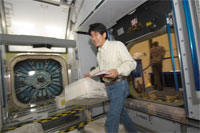
Astronaut Doi in the ISS mockup simulating transfer operations for transferring supplies and/or used items between space shuttle and ISS
Astronaut Doi, along with his STS-123 (1J/A Flight) Mission crewmates, participated in the training for transfer operations scheduled during their mission, by using the ISS mockup at NASA Johnson Space Center (JSC).
The crew members who will conduct the transfer operations are required to be flexible and ready since each crew member’s timeline is subject to change on a daily basis. It’s critical to effectively manage and carry out transfer tasks in order to minimize any loss of crew time. To this end, it is important that all crew members be able to work in a coordinated manner.
During the STS-123 Mission, astronaut Doi will serve as the load master, the astronaut responsible for the transfer operations. He will play an important role during the mission in managing the transfer items, providing transfer instructions to other crew members, and reporting the progress to the Mission Control Center.
Training for the installation and activation of the Kibo Pressurized Module (PM)
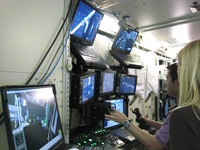
Astronaut Hoshide (second from the right) and NASA astronaut Karen Nyberg (far right) simulate operating the Canadarm2 in attaching and installing the Kibo’s PM, on a simulator
Astronaut Hoshide along with his STS-124 (1J Flight) Mission crewmates participated in training at NASA Johnson Space Center (JSC) on the assembly and activation of Kibo’s Pressurized Module (PM), tasks that they will be undertaking during their mission.
During the STS-124 (1J) Mission, astronaut Hoshide will operate Canadarm2 to install Kibo's Pressurized Module (PM) to Harmony, the ISS Node 2 connecting module. Astronaut Hoshide will also support the operation of Harmony’s attaching mechanism, the Common Berthing Mechanism (CBM). Astronaut Hoshide and his fellow STS-124 (1J) Mission crewmates simulated operation of Canadarm2 and the CBM from the mock-up of Destiny, the US laboratory module, at JSC. During the training, the astronauts trained on responding to both nominal and anomaly conditions.
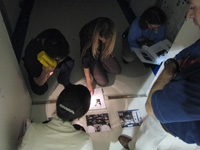
Astronaut Hoshide(left back - holding yellow flashlight) during training for troubleshooting an anomaly condition
The astronauts also participated in training on the activation of the PM. During the mission, in coordination with the flight controllers on the ground, astronaut Hoshide and his fellow STS-124 (1J) Mission crewmates will initiate activation of the PM, including sending commands from the Portable Computer System (PCS) on board the ISS that will activate the JEM Control Processor (JCP), which is the nerve center of Kibo’s PM. The training also confirmed the start-up procedures, as well as, provided training on troubleshooting anomalies.
A series of Joint Multi-Segment Training (JMST) exercises for STS-124 Mission, which simulate the STS-124 mission-specific operations, have been held since December 2007. The JMST deepens the cooperation and understanding between the STS-124 crew members, the JAXA Flight Control Team (JFCT), and the NASA flight controllers. To simulate the actual operations during the mission, the mission controls of the ISS partner countries, the Russian Federal Space Agency (FSA) and the European Space Agency (ESA), which are involved in the ISS operations, have been participating in the JMST.
Cell Biology Experiment Facility (CBEF) operations training

Astronaut Yamazaki operating the CBEF
Astronaut Yamazaki, along with members from the JAXA Flight Control Team (JFCT), participated in training on operating Kibo’s Cell Biology Experiment Facility (CBEF) at the Tsukuba Space Center (TKSC).
The purpose of this training was to help the JFCT members better understand the procedures that the ISS crew will follow while conducting experiments using the CBEF.
During this training, the participants reviewed the procedures for opening and closing the incubation chamber, and for mounting the containment canisters that will contain the experiment samples, by using the Ground Test model that’s normally used for training and testing.
Astronaut Wakata's lecture titled “The Era of living in space”
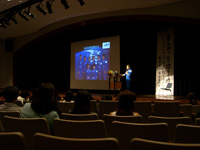
Astronaut Wakata giving his lecture
Astronaut Wakata gave a lecture at the Japanese Educational Institute at Houston, Texas, USA, titled “The Era of living in space - the long-awaited launch of the Japanese Experiment Module, Kibo". Approximately 600 people attended the lecture, with the majority of the audience being students.
Astronaut Wakata talked on a variety of topics related to space, including the solar system, an introduction of the International Space Station (ISS), the Kibo Japanese Experimental Module, and the H-II Transfer Vehicle (HTV). Astronaut Wakata also talked to the audience on the importance of the global environment and on the importance of having dreams from an astronaut’s perspective.



